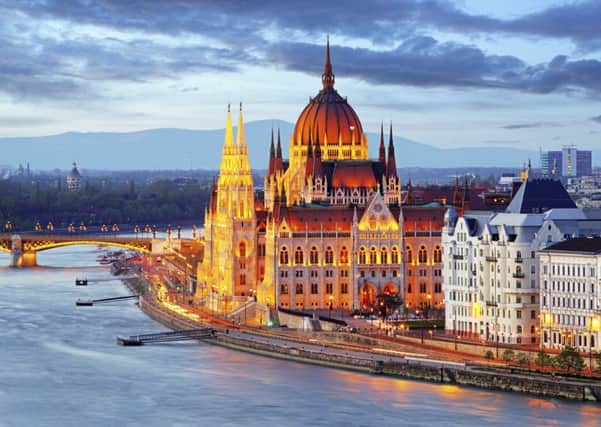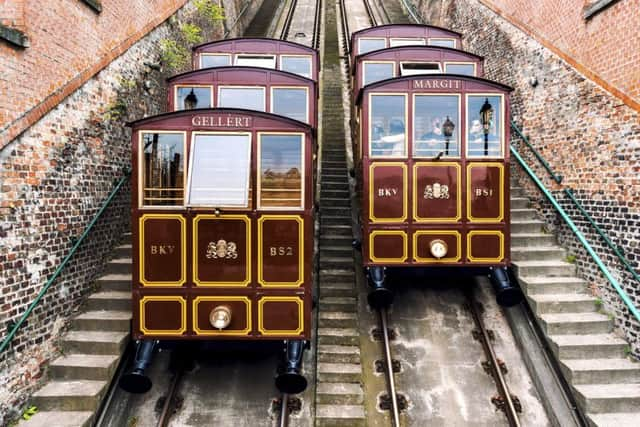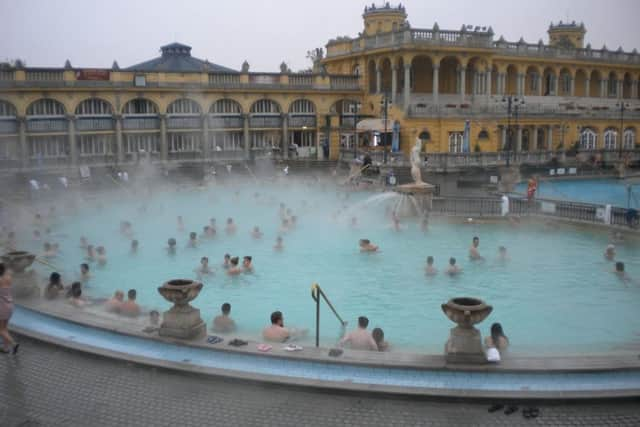Travel: Bathrobes and bunnets in Budapest


This article contains affiliate links. We may earn a small commission on items purchased through this article, but that does not affect our editorial judgement.
THERE was only one thing I wanted to buy at the Christmas market in Budapest and that was a hat. With a head so cold you could have chipped my ears off, it was a matter of urgency, but the choice of headwear in Vörösmarty Square was overwhelming.
Budapest’s main Christmas market was in full swing and crowds lured by the aroma of goulash, pork and cinnamon pastries thronged around the wooden stalls. Among the leather, candles and wooden gifts were teetering columns of bunnets and beanies, but which to choose? As the folk music from the stage played faster and faster and shopping paralysis began to take hold, I halted in front of a stall.
Advertisement
Hide AdAdvertisement
Hide Ad“Knitted by Hungarian grannies,” said the stallholder, indicating the hats. His granny? “No, but grannies.” Good enough for me, hand-knitted, 100 per cent soft wool, the real deal, for a fiver. I bought three.


Christmas shopping sorted, it was time for a mug of mulled wine and food at one of the outdoor cafés in the square. Ignoring the indignant gaze of litters of roasted suckling pigs, I feasted on stuffed cabbage while my companion gnawed on pork knuckles. If you’d rather be indoors, try Paprika (VII Dozsa Gyorgy utca 72) where they serve hearty authentic dishes like goulash soup, roast wild boar and fried chicken liver. Their flier says “giant portions for reasonable prices” and they’re not kidding. What they don’t say is that the food is amazing. Be sure to book.
Fuelled up, and armed with a Budapest Card that gives discounts on the baths, sights and museums, eateries and free public transport, it was time for a tour and I can wholeheartedly recommend Budapest Underguide. Their young local experts tailor tours to your interests – we opted for the art deco and ruin pubs tours – and they go that extra mile, in this case following in the footsteps of Lionel Richie on to the helipad of the President Hotel for a view of the incredible green and gold roof of the Savings Bank. The guides can also share experiences of life at the sharp end of history: being spied on by friends and neighbours, the repercussions of the 1956 uprising and what it means to be young in Hungary today, giving a more complex picture than the image sent out by a government that erects a fence to keep out immigrants.
Our art deco tour took in gems of Budapest’s architecture, including the Paris Department Store (Andrássy Street 39), Secessio Cafe & Delikat (Honved utca 3) which is also a museum of art deco furniture. At the Kazinczy Synagogue, Hungary’s folky take on art nouveau can be seen in tulips and bird motifs and the amazing windows by Miksa Roth, regarded as the greatest stained glass artist ever.
Budapest doesn’t wear its history lightly, for example at the spectacular Dohány Street Synagogue, where the courtyard became a graveyard. There a tree sculpture bearing victims’ names was donated by Bernard Schwartz, aka Tony Curtis, the child of emigré Hungarian Jews. Meanwhile, the Terror Museum does what it says on the tin. Located in the former HQ of the Hungarian Nazi Party and the KGB, the museum documents the effects of the terror on Hungary’s citizens. The tour ends, like the lives of many of its victims, in the torture cells in the basement. Although a clearer explanation of the artefacts on display would be helpful, it is nevertheless a powerful monument to the victims.


What a joy it was to escape along Andrássy Street and beyond to enjoy the beauty of the neo-renaissance and baroque buildings and squares of this fascinating city – Freddie Mercury was so taken with the vast parliament building he wanted to buy it. But visit in the winter and there will be times when you just want to get inside. Get warm, get steamy. No wonder baths are big in Budapest, with its 118 thermal springs. They’re what attracted the Romans in the 2nd century, the Turks in 16th, spa tourists in the 1920s and now us.
We had checked out the al fresco options at the famous Széchenyi baths with its lemon meringue pie architecture, where Magyar matriarchs and their hirsute hubbies bobbed about in the steaming waters like broiling lobsters. It was quintessential Budapest, but a layer of lycra against the cold didn’t cut it. And at the gloriously grandiose St Gellert Thermal Bath and Swimming Pools, a tram ride across the Danube on the Pest side of the city, you can appreciate both the warmth and the architecture as you gaze at the Zsolnay factory tiles and more Roth windows, chest high in warm water.
After that it was back to the Corinthia Hotel, formerly the Grand Hotel Royal, which bears striking similarities to the hotel in the film Grand Budapest Hotel. Josephine Baker, Sean Connery, Motorhead, Ridley Scott and Alex Ferguson have all stayed here, and who can blame them? Grand it is; think ballrooms, marble and residents padding along thick-carpeted corridors in fluffy white robes to the basement spa, with lounges that lay on so much food and drink that eating a meal in the dining room seems superfluous.
Advertisement
Hide AdAdvertisement
Hide AdAnd so our trip ended in the pub on another Underguide Tour celebrating Budapest’s ruin pubs. These started around 15 years ago in disused buildings such as the former stove factory that houses one of the originals, Szimpla Kert (Kazinczy utca 14). With its mismatched furniture and farmers’ markets, it’s full of character as is Fogashaz (Akácfa utca 51). Less of a ruin pub than a gastro pub is Farm (Ó utca 14) with food platters and a TV screen showing a couple dining in the dark in an enclosed room next door, their fumblings captured by infra-red cameras. Another Budapest craze is “exit rooms” where punters pay to be locked into a venue and solve clues to find their way out. Well, the city is the birthplace of Harry Houdini. My sense of adventure doesn’t stretch that far, but I did try töpörtyu, deep fried soft pig rind, because I didn’t know what it was, and palinka, the fiery local fruit brandy, because I did.
Finally, for a taste of true authenticity, try Wichmann’s Pub (Kazinczy utca 55), owned by former Olympic canoeist Tamás Wichmann, where a schnitzel sandwich (the only item on the menu) and a glass of beer cost a couple of euros. A hidden gem, it’s where the locals can afford to drink and you’d probably walk right past if you weren’t looking for it. Wichmann’s doesn’t try too hard, in fact it doesn’t try at all, but it’s 100 per cent Budapest. Twitter@JanetChristie2
• Book a room at the Corinthia Hotel between 11 January and 24 March for half price, as long as you stay during 2016. Rates start from £63 per room per night. The Corinthia’s New Year’s Eve package, from £353.45, includes transfers, accommodation for two with breakfast, in-room gift on arrival, spa access, New Year’s Gala dinner and show on 31 December. See www.corinthia.com/hotels/budapest/offers/entertainment/new-years-eve-2015. Corinthia Hotel Budapest, Erzsébet körút 43-49, Budapest H-1073, Hungary, tel: +36 1 479 4000.
Flights from Edinburgh to Budapest with Jet2.com from £37 one way including taxes, visit www.jet2.com, or call 0800 408 5599. Budapest Underguide Tours and Events, email [email protected] for prices (underguide.com, +36 30 908 1597). Tipsy Tour from £36 depending on group size and various other tours. St Gellert Baths, 1118 Budapest, Kelenhegyi ut 4 (www.gellertbath.hu), day tickets from £11.20. Széchenyi Baths, www.szechenyibath.hu in the City Park, entry from £3.77. House of Terror, Andrassy ut 60, Budapest, from £4.57. Budapest Card (www.budapest-card.com) 24 hours £11/48 hours £18/72 hours £22.50. Includes free public transport, entry to museums and some baths and sights.